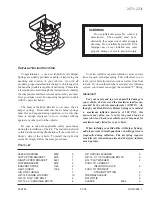
2.4.2 Description and Operation
2.4.2.1 Heated Oxygen Sensor (HO
2
S)
Heated Oxygen Sensors (HO
2
S) are installed before and after
the three-way catalytic converter. Heated oxygen sensor sends
signals to the engine control module (ECM) indicating oxygen
content in the exhaust. the engine control module controls the
fuel injectors to change the engine Air-Fuel ratio. The ideal Air-
Fuel ratio is 14.7:1, at this time the catalytic converters is most
efficient. As the fuel injection system continuously measures
and adjusts Air-Fuel ratio, it is called "closed loop" control.
1. Open-loop
When the engine has just started and the speed is higher than
400 rpm, the system enter "open loop" operation. In the open-
loop mode, the engine control module (ECM) ignores the signal
from the heated oxygen (HO
2
S) signal and according to signals
from the engine coolant temperature sensor (ECT) and intake
pressure temperature sensor to calculate the Air-Fuel ratio.
Sensors will remain in the "open loop" mode, until the following
conditions are met:
–
Heated oxygen sensor voltage output changes, showing
that the temperature is high enough and the system can
enter the normal operation.
–
Engine coolant temperature sensor in higher than the
specified temperature.
–
The engine has been started for the specified period of
time.
2. Closed-loop
In the above mentioned situation, the specific values depend
on different engines and are stored in electrically erasable
programmable read-only memory (EEPROM). When these
conditions are met, the system enters into "closed loop"
operation. In the "closed loop", the engine control module
calculates Air-Fuel ratio according to oxygen sensor signals (ie,
fuel injector connected timing), so that the Air-Fuel ratio is
always very close to 14.7:1.
Note
Once the engine control module confirms oxygen sensor
faulty, the system will be immediately in "open loop"
control, that is the Air-Fuel ratio is no longer adjusted
according to the oxygen sensor signals.
2.4.2.2 Evaporative Emission Control System
Evaporative emission control system uses the basic principle
of Canister storage method. This method transfers fuel vapor
from fuel tank to the carbon storage devices in order to save
the steam when the vehicle is not running. When the engine is
running, the fuel vapor is sucked out from the Canister and
burnt in the normal combustion process. Gasoline vapor from
the fuel tank flows into the fuel vapor recovery pipe. The vapor
is absorbed by the Canister. After the engine runs the required
time, the engine control module provides a ground circuit, so
that evaporative Canister clean-up solenoid valve is turned on
and the air is drawn into the Canister and mixed with vapor.
The mixture is then sucked into the intake manifold. The
evaporative canister clean-up is controlled by the pulse-width
modulated solenoid valve (PWM) signal to open or close.
According to the operating conditions determined by air flow,
fuel adjustment and intake air temperature, evaporative
Canister PWM duty cycle changes.
The following conditions can cause poor idling, stalling and
poor performance:
–
Canister Solenoid Valve Inoperative
–
Canister Damage
–
Hose Disconnected, Cracking, Improperly Connected To
The Pipeline
Evaporative canister is an emission control device containing
active carbon particles. Evaporative Canister is used to store
fuel vapor from fuel tank. When certain conditions are met, the
engine control module will provide the Canister solenoid valve
power, so that the fuel will be sucked into the engine cylinder
and burnt off.
2.4.2.3 Purged Crankcase Ventilation (PCV)
System
Compressed combustion gases fleeing into the crankcase
through the piston rings is known as channeling gas.
Channeling gas contains nitrogen oxides, carbon monoxide
and hydrocarbons. Crankcase ventilation system prevents the
channeling gas entering into the atmosphere. Crankcase
ventilation system will force the channeling gas crankshaft
back into the intake system and the combustion chamber.
Crankcase ventilation system consists of the following
components:
–
Purged Crankcase Ventilation Valve
–
Crankcase Ventilation Tube
–
Hose and Connectors
2-258
Auxiliary Emission Control JL4G18-D
Engine
EC718/EC718RV EC715/EC715RV 10/2009
Summary of Contents for EC715 2009
Page 4: ......
Page 330: ...Next Step 10 End 2 248 Fuel System JL4G18 D Engine EC718 EC718RV EC715 EC715RV 10 2009 ...
Page 1164: ......
Page 2008: ......
















































